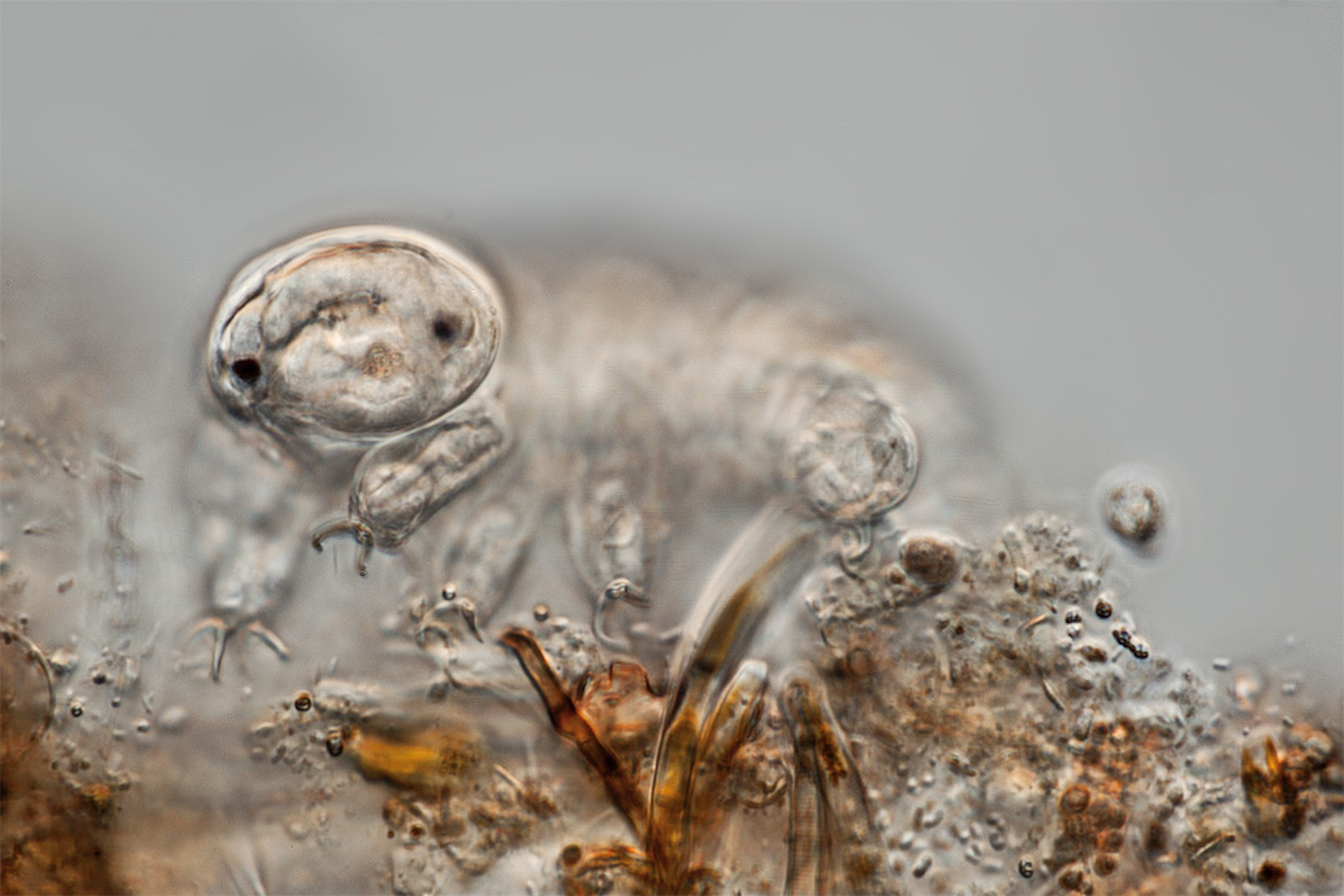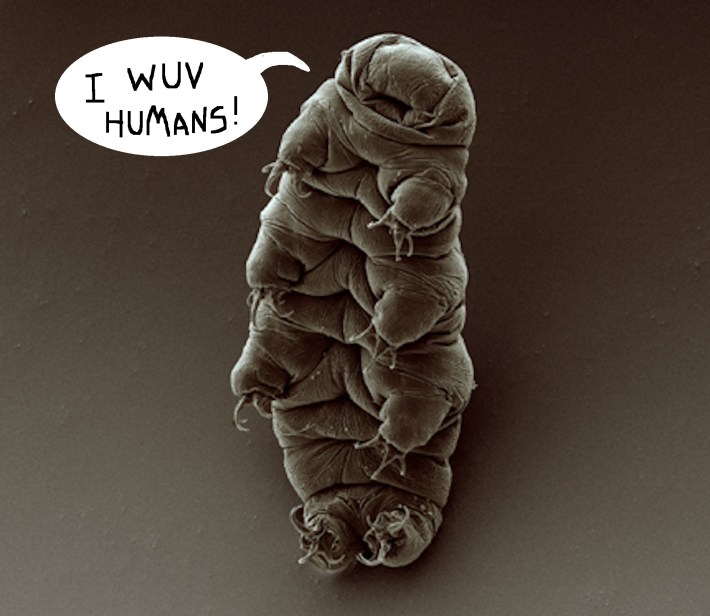Leave Tardigrades Alone!
1:26 PM EDT on May 20, 2021

Do not shoot this poor little fellow from a gun!
You, a kind and decent person and lover of all of our planet's gentle animals, will be pleased to learn that tardigrades used in a recent experiment conducted by researchers at the University of Kent were "handled according to the ethical rules for invertebrates with the consent of the departmental ethics officer." That's a relief: Tardigrades, after all, are sweet little microscopic chunksters, lovers of moss and fresh water, harmless little fellows with nicknames like "moss piglets" and "water bears." They live all over, merrily going about their business in all environments, in some cases in conditions you or I would find explosively, gruesomely unsurvivable. They're tiny little eight-legged manatees. Unambiguously cute. I for one am glad to know that tardigrades used in human scientific experiments are watched over by an ethics officer and handled according to established ethical rules. Whew.
Why, here's one now, stopping by to say just how much he appreciates not being subjected to extraordinary violence in order to marginally advance humankind's understanding of astrobiology. Hi buddy!

That's nice. So how'd that experiment at the University of Kent go? How were our friendly tardigrade pals handled, under the watchful eye of a dedicated ethics officer? Well, first they were fed mineral water and moss (yum) and then two or three at a time were loaded into a water-filled shaft inside a nylon encasement called a "sabot." Tardigrades enjoy water environments, so this sounds pretty cozy. Then the sabot was, ah, frozen solid for 48 hours, putting the tardigrades into a period of suspended animation known as a "tun state." This is less good but ultimately acceptable, because tardigrades will reliably return to normal life after nine hours of thawing following this sort of deep freeze. So at the end of the experiment the little guys would go right back to munching on moss, none the worse for wear! Yay!
So what happened to the sabots between freezing and thawing, you are asking? How would scientists use these frozen capsules, carefully ensconcing a small group of brave little sleeping tardigrades, to advance our understanding of the universe? For answers, let us turn to the journal Astrobiology, which published the results of the study earlier this month:
They were fired from a two-stage light gas gun at sand targets in a vacuum chamber. The whole sabot impacted the target in each shot. Six shots were executed at speeds from 0.556 to 1.00 km s−1.
If I am understanding this correctly, it is considered ethically upstanding to freeze tardigrades inside a bullet, load the bullet into a gun, and fire the gun at a solid target? This seems at the very least to be extremely rude, but at least we know that tardigrades, which can live in outer space and survive acute radiation and prolonged starvation, are perhaps the hardiest, most resilient animals on the planet. Surely the ethics officer established at the outset that being frozen halfway to death and then smashed into things at unfathomable speeds would minimally upset the little water bears?
In the shots up to and including 0.825 km s−1, intact tardigrades were recovered post shot, but in the higher-speed shots only fragments of tardigrades were recovered. Thus, shortly after the onset of lethality, the tardigrades were also physically broken apart as impact speed increased.
Sweet Jesus! So the sleeping frozen tardigrades were killed and also ripped apart like wads of wet toilet paper? I am having trouble imagining an ethics officer signing off on this experiment and also considering herself good at her job! These so-called "ethical rules" evidently allow you to quite literally explode your invertebrates so long as you treat them to a meal of moss and mineral water first. I highly, highly doubt the tardigrades understood the nature of the bargain when they sat down for that final meal. Enjoy your supper, sweet moss piglets, for soon you will be a grisly spray of frozen shrapnel.
These University of Kent scientists did this invertebrate-exploding in order to explore the conditions whereby a life form, even if only as rudimentary a life form as the tardigrade, could survive a particular kind of interplanetary journey in the cosmos. When one chunk of floating space matter—say, a small asteroid—collides with another chunk of floating space matter—a planet, for instance—quite a lot of junk is blasted away by the force of the impact. This ejecta rockets off into space, carrying along with it whatever smaller crap happened to be stuck on that disembodied chunk when it was ejected. Most of this smaller crap—perhaps a humanoid alien named Zhris Zhompson, his used Zord Zocus, the several bundles of used plastic shopping bags in the backseat that he's been meaning to deposit in the recycling bin for the last nine years—is either obliterated in the collision or fried to a deep crisp by the heat of the explosive impact or tear-jerkingly frozen to death like Tim Robbins in Mission to Mars. But certain small things—certain panda-looking microorganisms who enjoy lichen, travel, and long walks on the beach—are able to survive extreme pressures, extreme temperatures, and, yes, the utter inhospitability of outer space.
There is a word for the theory of living organisms being distributed throughout space on meteoroids, space dust, comets, and contaminated spacecraft, among other forms of space debris, and it is "panspermia." Simply put, the Kent researchers want to know whether it is possible for Mars to be colonized by tardigrades that blow off of Earth in a meteoroid impact, or—more fascinatingly by far—whether it is possible that tardigrades or tardigrade-like organisms blew off Mars and brought life to Earth. The average speed of impact of terrestrial ejecta on the Moon—yes, this happens, shit blows off Earth and smites the Moon—is apparently too high for tardigrades to ride along and live to tell about it, but "a notable fraction (around 40 percent) of such ejecta impact at vertical speeds low enough to permit survival."
Similarly, martian impact ejecta striking Phobos, for example, at a typical impact speed will not permit viable transfer of tardigrade-like organisms, but if a fraction of such material had a lower impact speed, survival may be possible.
What the scientists learned is that the tardigrades—those that were not quite literally shredded to death, anyway—mostly survived the process of being frozen and then shot from a gun into a solid target. Mark Burchell, one of the two researchers involved in the experiment, told Motherboard that these findings were "a surprise in that the tardigrades seemed to recover from impacts, right up to speeds which started to physically tear them into pieces." At least from the collision end of lithopanspermia, tardigrades appear suited for colonization.
And at this point they deserve a chance, if only to escape the horrors of ethical treatment! Personally I would like to see tardigrades establish a new, safer home on the red planet, where they can have their own "ethical rules for invertebrates" that do not include being plied with food and drink and then frozen solid and brutally dismembered. Perhaps there they can grow in both wisdom and size, until they are 50 feet tall and technologically advanced and capable of interplanetary travel, and will return to Earth with vengeance on their minds and a light gas gun and several man-sized sabots of their very own.
If you liked this blog, please share it! Your referrals help Defector reach new readers, and those new readers always get a few free blogs before encountering our paywall.
Staff Writer
Read More:
Stay in touch
Sign up for our free newsletter




